|
If he had sat in mission control alongside the scientists in charge
of the Cassini spacecraft when it made its climactic entry into
Saturn's orbit, Galileo Galilei would have been astonished. When he
discovered the planet in 1610, looking through his primitive
telescope, Galileo perceived Saturn's rings as two large moons,
which he described as "handles," flanking the planet. He was baffled
two years later when these moons seemed to disappear. (In fact,
Saturn was then at a different tilt relative to Earth, and Galileo
could not make out the thin edge of the rings.) Below, explore how
Cassini is helping to answer fundamental questions about Saturn's
rings, and marvel at close-up imagery that Galileo could never have
imagined.—Susan K. Lewis
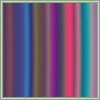

|
|
How Old Are the Rings?
Saturn and the other planets of our solar system coalesced
from swirling clouds of interstellar gas roughly 4.6 billion
years ago, and scientists long assumed the rings dated back to
this time. But images from Voyager in the 1980s and now from
Cassini point to a younger age. It even appears that some
rings are still being made. Scientists use dust contamination
as a kind of clock to estimate the age of the icy rings.
Saturn's main rings seem to be a mere few hundred million
years old.
Left: Cassini's ultraviolet spectrometer reveals varying
levels of dust in the main rings. "Dirtier" rings are red; the
blue rings farther out likely formed later.
|
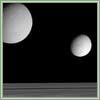

|
|
How Did They Form?
It now seems that the rings were not all created from
interstellar gas when the mother planet was born. So where do
they come from? A medium-sized moon might have strayed so
close to Saturn that it was pulled apart by the planet's
gravity, or it might have been shattered by a meteor. Another
theory is that a large meteor or comet ventured too near
Saturn and was torn apart. And Cassini now provides yet
another explanation for the E ring, which lies outside the
main rings: geysers on the moon Enceladus are feeding the E
ring's growth.
Left: Saturn has more than 40 moons ranging from a few miles
to 3,200 miles across. A medium-sized moon, if shattered,
would account for the entire mass of the rings.
|
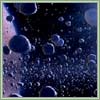

|
|
What Are They Made Of?
Countless billions of "particles" constitute Saturn's rings.
Some are as fine as powdered sugar, but others are as big as
barns, and a few are so large they may more aptly be called
small moons. The Voyager mission found that the particles are
nearly pure water-ice, with traces of dust and rocky matter
that come from meteors. Temperature data from Cassini are
slightly altering the picture, hinting that the particles of
the main rings may be more like fluffy snowballs than ice
cubes.
Left: From Earth the rings look like solid disks, but if you
could fly inside them, you would see a blizzard of icy
particles.
|
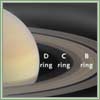

|
|
How Many Rings Are There?
Saturn's main rings, visible from Earth through amateur
telescopes, are part of a larger, intricately structured
system. It includes seven major named rings, alphabetically
labeled in the order in which they were discovered. Closest to
Saturn is the faint D ring. Moving outward are the C, B, and A
rings (the main rings). Just outside of the A ring lies the
narrow F ring, and beyond it the thin G ring. The outermost
ring, the E ring, is broad and diffuse, extending all the way
to the moon Titan.
Left: Within Saturn's main rings (from left to right C, B, and
A), there are tens of thousands of narrower ringlets, most
just a few miles wide.
|
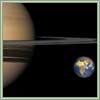

|
|
How Vast Are They?
It all depends on what you mean by "vast." In terms of mass,
the rings aren't terribly impressive; pack all the ring
particles together, and you would make a medium-sized moon.
But the rings cover an extraordinary expanse of space. The
main rings are about 170,000 miles in diameter, yet less than
half a mile thick. (Imagine a paper-thin ring that stretches
two miles across.) The E ring's diameter is nearly 600,000
miles. Flying in a high-speed passenger jet, it would take you
more than a month to cross this distance.
Left: To put the size of the rings in perspective, consider
that Saturn itself is over 750 times larger than Earth.
|
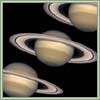

|
|
Why Do They Lie in One Plane?
When Saturn formed from a spinning disk of gas, the material
left over continued to swirl around the planet's equator. Much
of it coalesced into moons. Whether the rings date back to
this process or are the remnants of a shattered moon, the ring
particles would keep the angular momentum of the original
spinning disk. Saturn's gravity is also stronger around its
bulging middle, so particles tend to be drawn there. Lastly,
any ring particles on an inclined orbit would soon collide
with the billions of particles at the equator and be herded
into the same plane.
Left: As Saturn tilts on its axis, the majestic rings tilt
with it. This montage of Hubble images, captured from 1996 to
2000, shows a change of seasons on the planet.
|
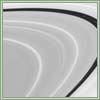

|
|
What Makes Gaps in the Rings?
Through their gravitational effects, Saturn's moons shape
striking dark gaps in the rings. The largest gap in the main
set of rings, nearly 3,000 miles wide, is the Cassini
Division, named after Jean-Domenique Cassini, who discovered
it in 1676. It separates the main rings B and A. While this
"gap" actually contains faint ringlets and is not as empty as
it appears from Earth, its inner boundary is kept sharp by the
moon Mimas. Other, smaller moons help keep the Encke and
Keeler Gaps of the A ring open.
Left: In this contrast-enhanced image, the 200-mile-wide Encke
Gap (left) and 26-mile wide Keeler Gap can be seen within the
bright A ring. So-called shepherd moons maintain the
boundaries of these gaps.
|
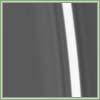

|
|
What Makes Bright Bands in the Rings?
The brighter bands of the main rings are essentially areas of
greater particle density, which reflect more sunlight. (By
contrast, when you look at the dark side of the rings, these
bands block sunlight from shining through and appear darker
than neighboring bands.) While scientists do not completely
understand what determines the locations and boundaries of all
the bright lanes, some at least are shaped by the gravity of
Saturn's moons.
Left: The bright band in this close-up view of Saturn's C ring
has a particle density some five times greater than in the
surrounding regions. The band is roughly 30 miles wide.
|
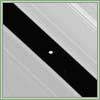

|
|
Are There Moons Within the Rings?
Yes. While most of Saturn's 40-plus known moons orbit outside
the main ring system, the Voyager mission discovered a tiny
moon orbiting within the A ring. Astrophysicists had predicted
that such a moon might exist and be responsible for creating
the 200-mile-wide Encke Gap. Now Cassini has confirmed
suspicions that an even tinier moon is embedded in the A
ring's Keeler Gap. The gravitational fields of these moons
sweep the gaps clear of particles; if the diminutive moons
didn't exist, the gaps wouldn't either.
Left: In this view of the A ring, the moonlet Pan appears like
a speck in the middle of the Encke Gap. Pan is just 16 miles
across. The Keeler gap is at the upper right, but its
four-mile-wide embedded moon is not pictured here.
|
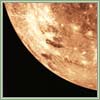

|
|
Do the Rings Have an Atmosphere?
Cassini revealed that the rings have an atmosphere of sorts
comprised largely of molecular oxygen. It is too thin and
tenuous to be considered a true atmosphere, but it is
nonetheless surprising given the ring's small total mass and
weak gravity. Molecular oxygen is generally associated with
biological processes, but in the rings it is made when
ultraviolet light splits apart water molecules. Even if some
oxygen gas escapes the ring's gravity, the thin atmosphere is
continuously replenished with fresh oxygen.
Left: The thin atmosphere of Saturn's rings is probably like
that of Jupiter's icy moon Ganymede, the largest moon in our
solar system.
|
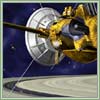

|
|
How Did Cassini Pass Through the Rings?
The most nail-biting part of the spacecraft's seven-year
voyage to Saturn was the 90 minutes when Cassini crossed the
ring plane to enter orbit. Given that ring particles move
faster than high-speed bullets, how did Cassini survive?
Mission planners chose a 15,000-mile-wide gap in the rings,
between the F and G rings. They also positioned the
spacecraft's high-gain antenna as a shield. Cassini was indeed
hit many times by fine grains of ice, but the crossing was a
success, as the glorious imagery and invaluable data from the
mission make clear.
Left: An artist's vision of Cassini. After crossing the ring
plane (to the left of the main rings shown here), the
spacecraft had to fire its engines and reduce its velocity in
order to be captured by Saturn's gravity and enter orbit.
|

|

|

